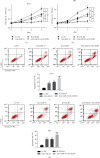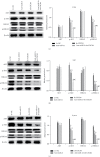Double-Targeted Knockdown of miR-21 and CXCR4 Inhibits Malignant Glioma Progression by Suppression of the PI3K/AKT and Raf/MEK/ERK Pathways
- PMID: 33123586
- PMCID: PMC7584940
- DOI: 10.1155/2020/7930160
Double-Targeted Knockdown of miR-21 and CXCR4 Inhibits Malignant Glioma Progression by Suppression of the PI3K/AKT and Raf/MEK/ERK Pathways
Abstract
Currently, miR-21 and CXCR4 are being extensively investigated as two key regulators in glioma malignancy. In this study, we investigated the combined effects of these two factors on glioma progression. Herein, the expression of miR-21 and CXCR4 was increased in tumor tissues and cell lines. Inhibition of miR-21, CXCR4, and miR-21 and CXCR4 together all reduced the migration, invasiveness, proliferation, and enhanced apoptosis in glioma cells, as well as reduced tumor volume and mass in xenograft model. The inhibition effect was strongest in double-targeted knockdown of miR-21 and CXCR4 group, whose downstream pathways involved in AKT axis and ERK axis activation. In conclusion, our findings reported that double-targeted knockdown of miR-21 and CXCR4 could more effectively inhibit the proliferation, migration, invasion, and growth of transplanted tumor and promote cell apoptosis, which were involved in the PI3K/AKT and Raf/MEK/ERK signaling pathways.
Copyright © 2020 Feijiao Liu and Bo Yang.
Conflict of interest statement
No potential conflicts of interest were disclosed.
Figures






Similar articles
-
Long non-coding RNA LINC00152/miR-613/CD164 axis regulates cell proliferation, apoptosis, migration and invasion in glioma via PI3K/AKT pathway.Neoplasma. 2020 Jul;67(4):762-772. doi: 10.4149/neo_2020_190706N598. Epub 2020 Jul 23. Neoplasma. 2020. PMID: 32726126
-
MicroRNA-134 inhibits tumor stem cell migration and invasion in oral squamous cell carcinomas via downregulation of PI3K-Akt signaling pathway by inhibiting LAMC2 expression.Cancer Biomark. 2020;29(1):51-67. doi: 10.3233/CBM-191362. Cancer Biomark. 2020. PMID: 32568182
-
miR-489 inhibits proliferation, cell cycle progression and induces apoptosis of glioma cells via targeting SPIN1-mediated PI3K/AKT pathway.Biomed Pharmacother. 2017 Sep;93:435-443. doi: 10.1016/j.biopha.2017.06.058. Epub 2017 Jun 27. Biomed Pharmacother. 2017. PMID: 28666210
-
miR-372 regulates glioma cell proliferation and invasion by directly targeting PHLPP2.J Cell Biochem. 2015 Feb;116(2):225-32. doi: 10.1002/jcb.24949. J Cell Biochem. 2015. PMID: 25160587
-
The role of the CXCR4 cell surface chemokine receptor in glioma biology.J Neurooncol. 2013 Jun;113(2):153-62. doi: 10.1007/s11060-013-1108-4. Epub 2013 Mar 14. J Neurooncol. 2013. PMID: 23494875 Review.
Cited by
-
Development of a Synthetic, Injectable Hydrogel to Capture Residual Glioblastoma and Glioblastoma Stem-Like Cells with CXCL12-Mediated Chemotaxis.Adv Healthc Mater. 2023 Jun;12(14):e2300671. doi: 10.1002/adhm.202300671. Epub 2023 Apr 20. Adv Healthc Mater. 2023. PMID: 37014179 Free PMC article.
-
Chemoattraction of Neoplastic Glial Cells with CXCL10, CCL2 and CCL11 as a Paradigm for a Promising Therapeutic Approach for Primary Brain Tumors.Int J Mol Sci. 2021 Nov 10;22(22):12150. doi: 10.3390/ijms222212150. Int J Mol Sci. 2021. PMID: 34830041 Free PMC article.
-
Recent Emerging Immunological Treatments for Primary Brain Tumors: Focus on Chemokine-Targeting Immunotherapies.Cells. 2023 Mar 8;12(6):841. doi: 10.3390/cells12060841. Cells. 2023. PMID: 36980182 Free PMC article. Review.
-
Maintenance of Epstein-Barr virus latency through interaction of LMP2A with CXCR4.Arch Virol. 2022 Oct;167(10):1947-1959. doi: 10.1007/s00705-022-05511-w. Epub 2022 Jun 25. Arch Virol. 2022. PMID: 35752684
-
Modulation of the chemokine/chemokine receptor axis as a novel approach for glioma therapy.Pharmacol Ther. 2021 Jun;222:107790. doi: 10.1016/j.pharmthera.2020.107790. Epub 2020 Dec 11. Pharmacol Ther. 2021. PMID: 33316289 Free PMC article. Review.
References
-
- Yang X. J., Long H. A., Sheng-ping Y. U. Study on invasion and migration of malignant glioma. Chinese Journal of Contemporary Neurology & Neurosurgery. 2018;18(1):p. 36.
MeSH terms
Substances
LinkOut - more resources
Full Text Sources
Research Materials
Miscellaneous

